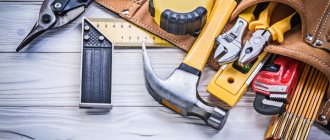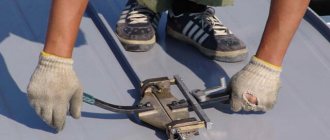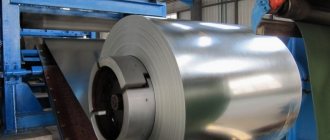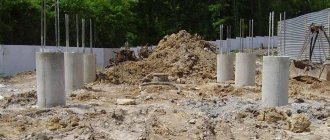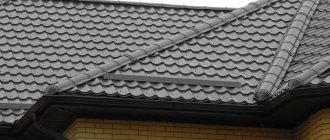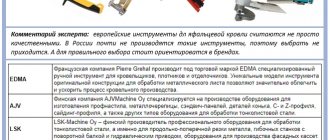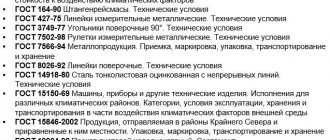Seam roofing is a great option for roofs with a slight slope. German craftsmen invented the seam roof (you may have already guessed it from the name). In translation, “seam” simply means a gutter, and the installation of a seam roof consists of such simple connections - snapped or clamped, and that’s it. But why then, with such simplicity, seam roofing is not common?
The problem is that previously the fold was made from sheets only by hand. The process was labor-intensive, the joints were not very smooth and it was difficult to talk about the tightness of such a roof. And only with the advent of professional equipment did seam roofing rediscover itself: smooth connections, any length and speed of installation did their job. Want to know more?
Seam roofing: device and installation technology
A roof made of sheet steel with a special connection of edges is called seam roofing. The seam is formed by special bending of the edges of metal sheets. They provide a nice, secure connection that includes a drainage groove. Building a seam roof with your own hands is as easy as any sheet roof. Only instead of rivets and welding they use a roofing seaming machine. Without it, it was previously impossible to make a seam roof, but now technology has been created that has simplified this task.
Required Tools
Installing a seam roof is impossible without special tools. To install the metal coating yourself, you should purchase the following devices:
- scissors with straight and curved cuts;
- special folding hammer with a short handle;
- rectangular and wedge-shaped mallet;
- mustache - a type of roofing mandrel for bending metal;
- pliers with different bending angles;
- chalyazin folded;
- perforator;
- building level;
- drill;
- Bulgarian;
- special pliers for opening seams.
To quickly connect roofing parts and facilitate manual labor, semi-automatic and electric seaming machines for seam roofing are often used. This tool effortlessly fastens the foxes into a double fold.
How is a seam roof constructed?
The roof frame consists of standard layers of the roofing pie: rafters, windproof membrane, sheathing, counter lathing. The front covering - rolled steel - is selected with galvanization or a polymer layer. The second option makes it possible to choose a roof shade that harmonizes well with the house and landscape.
The steel is laid in longitudinal strips, but it is not necessary that they be solid. For horizontal connections, a special type of fold is used: recessed. It is flat and practically invisible from the outside. The longitudinal edges are connected with a standing seam, forming a convex edge of a complex joint. This design of seam roofing provides the house with a durable structure with a warranty period of up to half a century. Also, the folded lock is divided into single and double: simpler and more complicated.
Benefits and Applications
Sheet steel is an inexpensive material that is easy to work with. One person and an assistant can cover the roof using this method; you just need to ensure that the sheets are lifted to the top. And the construction team is able to cope with such coverage in 2 days. Low cost and high quality made it possible to use it for the repair of residential and public buildings, as well as for covering new houses. The ability to carry out installation independently and quickly made standing seam roofing popular in private low-rise construction.
Folding machines
The second most important type of equipment needed to create a seam roof is seam seaming machines. They are divided into several categories.
Hand tools
Manual folding machines are often called frames or haps. They form a double standing seam in two steps. The work, of course, is labor-intensive, but the manual mechanism has one undeniable advantage - it can be used on highly sloping roofs and in hard-to-reach places where an automated device will not fit. Therefore, in addition to modern equipment, a serious team of roofers must have a folding handbrake.
The manual folding mechanism allows you to obtain a high-quality seam in hard-to-reach areas of the roof where the use of electrical devices is impossible
Video: Manual tool for closing double standing seam
Semi-automatic folding machines
Semi-automatic folding machines are installed at the beginning of the future seam and pulled with a cable, leaving behind a double folded connection. The use of semi-automatic machines ensures high installation speed compared to the manual method, as well as careful treatment of the protective polymer layer of the metal. Semi-automatic folding machines are most effective when laying long paintings.
Semi-automatic seaming devices are most effective when creating double seam seams on long panels
Video: operation of a semi-automatic folding device
Automatic folding devices
Electric designs for rolling seam seams are based on modern technologies that minimize the human factor when creating seam seams and greatly increase labor productivity. The mechanism of use is very simple - the device is installed in the proper place and turned on. The machine, moving in a given direction, itself connects the workpieces with a double fold. The result of their use is a durable and perfectly flat seam roof in record time.
Electric seaming machines, with virtually no human intervention, join roofing panels with a double standing seam, creating a high-quality seam in one pass.
Video: Wuko folding machine
Unfortunately, in the domestic market the choice of automatic electric folding machines is limited. The products of the famous German company Schlebach are represented by only three models:
The first one costs 337 thousand rubles, and the rest - about half a million. The folding mechanisms of the Austrian brand Wuko are not much cheaper - the only Wuko 1006 series can be purchased for 210 thousand rubles. Naturally, such perfect technical equipment can only be found among real professionals.
Reliability, longevity, quality and the undeniable attractiveness of standing seam roofing is a union of advanced technologies and installation skills, which is based on the knowledge, experience, tools and equipment necessary to perform such work. That is why their high cost is fully justified, which more than pays for itself in the further operation of the seam roof due to the absence of the need for special care and repairs.
Source
DIY installation
For a standard connection of panels, you need to purchase a machine for rolling seams. Don’t bother replacing it with handy means, this may disrupt the technology and affect the quality of the entire roof. If there is no opportunity or desire to acquire a machine, a self-latching seam roof with edges on which a special lock has already been formed is used. This type of sheet simplifies installation and speeds up work several times. The lock consists of a locking tooth that is covered by a hook when one metal strip is placed over another. All that remains is to latch the system, which takes literally a few seconds.
Tools for work
To install a seam roof you will need the following tools:
- screwdriver
- metal scissors
- hammer, mallet, pliers
- sealant gun
- folding machine
Fastening is done to a metal or wooden sheathing, continuous or in increments of no more than 40 cm. A waterproofing layer must be provided. Standard dimensions of sheets for installation of seam roofing:
- width 465 mm
- height of edges (locks) 40 and 45 mm
Self-locking technology makes seam roofing generally more expensive, but ease of installation and guaranteed quality of connections lead to real savings in roof construction.
Current: copper roofing
Stainless steel is not always chosen as the coating material. Copper seam roofing has a long service life and durability due to the properties of this metal. At first it stands out with a characteristic shine, then it becomes covered with patina and acquires a noble shade. Copper does not deteriorate for hundreds of years; such a roof with a seam joint will become truly durable.
Fastening features: clamps
Regardless of the metal of manufacture, the fold is divided into the following types:
- standing
- recumbent
- with stiffener
- with clamp fastening
Using clamps, panels of both types are installed: self-latching and using tools. A clamp in a seam connection allows you to attach metal panels to the sheathing completely unnoticeably. It comes in two types: movable and fixed. The first is used for sheets longer than 8 m, and the second for short sheets (up to 8 m). Direct fastening is done using a self-tapping screw with a press washer. The most reliable is the standing double seam. It is made by double bending the edges, thanks to which it differs in appearance: a characteristic convex longitudinal joint is obtained.
Installation features
The first and all subsequent panels are positioned with the bottom lock towards the next installation. The work is carried out from the bottom up, the distance between the longitudinal joints is 40 cm. There is no fundamental rule on which side to start installation from: left to right or right to left. The main thing is to respect the location of the lower lock. For metal sheathing, use self-tapping screws 4.8x20 mm, for wooden sheathing, 4.8x35 mm. If the sheathing is solid, fastening is carried out at a distance of at least 40 cm; if the sheathing is sparse, the fastening is done in each row. In places where sheets adjoin pipes and walls, a wall profile is used.
Preliminary calculations
The manual machine consists of a movable frame (traverse) with an angle and a static support on which the bending lever is located. The bed is designed in such a way that when the sheet is pressed tightly against it, the edge, clamped in the clamp, takes on the required bending shape. For manual processing, the maximum thickness of the metal sheet usually does not exceed 0.8 mm. The force applied by the machine does not allow creating even folds when using thicker sheets.
The simplest manual sheet bender is assembled on a monolithic base - it can be a table, metal scaffolding or any other base. For the mobility of equipment, it is important to assemble a mobile base - this can be any stable base made of a profile pipe or wooden beam.
Production technology
The seam-rolling machine is indispensable both for arranging the seam roof itself and for the production of auxiliary roofing accessories. This includes elements of the drainage system, front and end roof overhangs, and it is also used to make galvanized ventilation ducts.
Types of folds
A seam connection is a twist between two adjacent sheets of metal, and in order to arrange this twist, you need to bend the fold along the edge of the sheet, and it is precisely to bend this fold that you need a seam rolling machine.
There are 2 folded joints - these are single and double folds, plus folds can be standing or lying.
The level of tightness depends on the choice of connection.
- A single fold is considered the basis, here one sheet is simply bent at 90º, and on the second sheet a kind of hook is made and after joining this hook is crimped;
- A double fold can be called an analogue of a single fold, only the twisting is done in 2 turns. To wrap the metal this way, the size of the hook in the workpiece must be smaller, on average about 5-7 mm, and the height of the workpiece must be, on the contrary, larger.
As for the recumbent connection options, they are exactly the same as the standing ones, only turned to one side.
Nowadays, L-shaped roofing seams are quite common; there is no practical benefit from such a connection, it is no better or worse than a double bend, but many believe that the roof looks much more impressive this way.
The L-shaped rebate looks especially good on rounded radii.
When selecting equipment, keep in mind that there are machines for arranging recumbent folds, standing folds and universal units that can be adjusted as necessary to any type of bend.
General information about machines
The main advantage of a seam roof is that the covering is monolithic, without any fastening or connecting holes. But the roofing metal itself is quite thin and making blanks in production and then transporting them to the site is inconvenient and often unrealistic.
A small folding machine makes a big difference. With such equipment, you can make blanks directly on site; moreover, there are models that can be installed directly on the roof.
There is one more important nuance: to bend the edges of sheets, you need a folding machine, and to make a double fold and crimp the connection, bringing it to the final result, a folding machine is used.
The seam settling machine significantly reduces the time of roof installation.
Often, the thickness of metal for roofing works ranges from 0.5-1 mm, with a maximum of 1.2 mm. But a good machine for standing seam roofing is designed to work with metal from 0.3 to 1.5 mm.
Such equipment is already closer to professional, and it can be used to make not only roofing paintings, but also to bend blanks for various kinds of drainage or ventilation pipes, plus make valley gutters and ridge caps.
By the way, the blank for a seam roof (a strip of roofing metal with curved seams) is called “Picture” among professionals.
The very principle of operation of the unit is simple: any folding machine has a number of crimping shaped rollers, which actually bend the edges of the sheet. Crimping rollers are installed in pairs on crimping shafts.
A manual folding machine is well suited for amateur use.
The number of such crimping shafts may be different, but no matter how many there are, they are driven by a gearbox, and the gearbox itself rotates thanks to an electric motor. There is, of course, manually operated equipment, but the productivity there is very low and such devices are rare.
Fine tuning of equipment
One more aspect. All supplied metal in rolls always has a certain width tolerance. For example, for 1250 mm this is 5 millimeters. If you cut the roll with one pair of knives, you will get a half spacing of 2.5 mm.
But for profiled metal this is undesirable, because such unevenness over the entire width during the production of seam paintings will form ripples and lead to premature wear of both the machine and the installation tool.
Most quality roofing machines are designed to be used exclusively in warm, clean rooms, like a workshop. They are not suitable for placing it outside in the open air. After all, different atmospheric conditions may have their own difficulties.
For example, trapezoidal threads easily become clogged, which leads to jamming and misalignment of carriages with profiled rollers. And such a machine will often have to be returned for repairs.
It is also important to pay attention to the nameplate with the serial number of the machine and the coordinates of its manufacturer. This way you will understand whether such a machine was made in some garage. You can finally be convinced of the quality of the purchased mobile folding machine only after releasing the first roll
You can finally be convinced of the quality of the purchased mobile folding machine only after releasing the first roll
If you see ripples on the first sheet, it’s bad.
You can finally be convinced of the quality of the purchased mobile folding machine only after releasing the first roll. If you see ripples on the first sheet, things are bad.
But here we will make a small digression. An experienced roofer knows that even in a high-quality metal roll, with its exactly the same thickness along the entire length, the rigidity will vary. It depends mainly on the carbon concentration in the metal melt. Literally the next roll may already have different characteristics, although its metal thickness will be exactly the same.
In addition, it is of great importance what kind of metal you purchased to make your paintings. For example, relatively recently, metal from the Novolipetsk Iron and Steel Works with a thickness of 0.55 mm was the market leader. It had excellent stiffness ratings and was compatible with certain equipment.
But now quite a lot of offers have begun to come from all over the market, especially from China, which offers metal with a thickness of 0.4 mm. That is why manufacturers, receiving feedback from their customers, slightly adjust their equipment to new types of metal. Namely, the configuration of the forming rollers and calibration transitions.
For this purpose, for example, in models such as Mini-prof there are special plastic rollers at the very end of the machine. They can be adjusted and fine-tuned to the required metal hardness. That is, you roll the metal and constantly monitor the linearity of the panel, adjusting it so that there is minimal wave effect on the roof card.
Which manual folding machine is best?
Work related to the construction of buildings and installation of roofing is carried out using modern equipment.
Manual folding machine
For this purpose, machines are used to create seams. This can be a homemade machine, made with your own hands, or a factory analogue, for example, the SFP 700 folding machine.
Why do you need a manual folding machine?
To create a seam roof, sheet or rolled metal is used. The edges of such a roof are connected by means of a special seam - a fold. Forming a waterproof seam seam is possible using a device such as a seam rolling machine lc 12r or SFP 700.
The main purpose of such a unit is to provide mechanical bending of sheet metal for roofing in order to create seams. Renting a folding machine is relevant if the volume of work being carried out is not large.
When using the SFP 700 device, all types of roofing can be made in the form of rolls, rather than separately laid sheets. Using the SFP 700 model machine, it is possible to significantly reduce the time required to complete work by several times, increase labor productivity and reduce the number of transverse roof seams to a minimum.
Renting a folding machine allows you to create double or even triple locks at the joints of the roof, and the finished panels will be equipped with rolled stiffeners. These elements will significantly increase the strength of the entire structure and improve the appearance of the roof.
The machine is needed to form a waterproof seam on a sheet of metal
Renting a folding machine is also relevant in cases where it is necessary to create a roofing picture of a rectangular, wedge-shaped or trapezoidal shape. In addition, the manual unit SFP 700 can be used to create:
- roofs;
- air vents;
- chimneys;
- low tides;
- slopes;
- drainpipe systems;
- decorative roofing bends.
The manual machine SFP 700 is intended for the production of various profiles on the edges of workpieces or sheets of galvanized steel. Materials with a polymer or paint coating can also be used.
The only significant drawback of the presented machine is the high cost and large dimensions of some models. However, a unit such as SFP 700 and its analogues differ:
- adaptability to the conditions of modern construction sites;
- no damage to the material coating;
- high quality of manufactured panels;
- possibility of manufacturing straight panels;
- the presence of stepwise readjustment for the required width of the workpiece.
Device Features
The manual machine model SFP 700 has modules such as a forming device, a bed and an electric drive. The frame is presented in the form of a welded metal structure on which the shafts are placed.
Steel rollers pull the metal strip along the machine
They ensure the formation of an even weld seam. The forming device pulls the metal strip along the machine. In this way, stiffening ribs and double-seam components necessary for interlocking roofing elements are created.
If you need to change the width of the metal strip, the device is manually adjusted to the new size. The electric drive of the SFP 700 unit consists of an electric motor, a chain-type transmission and a worm gearbox. The homemade machine can be additionally equipped with a roller unwinding device.
It is intended for installation, unwinding and further supply of metal in rolls. The unit can also be equipped with a device that connects the sheets into a continuous roofing sheet. The moving part of the machine includes two moving rods connected to each other by a clamping square.
Rolling process on a machine
The movable device is attached using springs at the top of the frame. It helps in inserting and removing the metal sheet after the edge is bent. The profiling mechanism is placed on a tubular steel frame. The rollers of this element are made using steel coated with a special finish.
It protects elements from the appearance of corrosive plaque. A homemade unit can be equipped with either a manual or automatic crimping device. In addition, for ease of transportation, a homemade machine must be equipped with four wheels.
Overview of common factory models
The SFP-700 mobile roof bending device is capable of producing panels equipped with a double standing seam. The machine can work with all types of roofing metal, including steel, copper, zinc or polymer coatings.
It is equipped with six working stands and has an optimized profile roller configuration. They ensure high quality of the manufactured coating. When working on a construction site, the presented machine can simultaneously serve up to two roofing crews. Among the advantages should be highlighted:
- light weight and dimensions of the device;
- simple and reliable design;
- the possibility of stepwise adjustment of the width of future panels from 200 to 700 mm;
- the ability to produce various types of panels - straight, trapezoidal, one-sided;
- possibility of installing a mechanical motor (in the absence of an electrical network).
The lC 12R seam rolling machine, like its analogue the lc 12r manual seam rolling machine (FPS), also prepares the edges of pre-cut roofing sheets. The model with the designation “R” produces 5 types of folds, including a standing one along the radius.
Manual folding machine lc 12r
Like the lc 12dr folding machine, the device marked “DR” is also capable of rolling up to 5 types of different folds. An additional advantage of the device is that it can form a connecting rail.
Seam rolling machines models STD-11019A and STD-11019A-01 can also be used for seam rolling, creating connecting strips and elements, as well as for rectangular air vents. The devices can work with thin-sheet low-carbon steels of any grade.
Sheet thickness can vary from 0.5 to 1 mm. The presented units differ:
- reduced noise characteristics of the working drive;
- improved capabilities for adjusting rollers;
- new electrical control circuit for the machine;
- the presence of screw supports for installation without a prepared foundation.
Making a folding machine (FPS) with your own hands
If desired, the machine can be made not only from metal, but also from wood. It will be able to bend metal and aluminum sheets of small thickness. The structure is strengthened with metal corners.
The crimping punch is attached to the base using wing nuts, underneath which washers with the appropriate diameter are placed. If necessary, punches can be manufactured in different sizes. This is especially convenient in cases where sheets of different thicknesses are to be processed.
If you need to make a sheet bender to work with thicker metal sheets, then it is better to use channels and corners instead of wood.
To create such a unit, you will need a welding machine to connect the parts. In this case, the design details will be similar: the punch that provides the clamp, the base and the clamp itself.
All parts must be oversized to accommodate larger consumables. It is important to ensure that the punch and clamp are 5-7 mm shorter than the base. After the clamp is installed in it, you need to drill two holes for the mounting bolts.
Homemade manual folding machine
The lever can be made from a reinforcing rod, which is pre-bent and welded to the corners. The diameter of the rod should not be less than 15 mm. The structure is then equipped with side protective panels. For this purpose, you can use sheet steel with a thickness of 5 mm.
Before welding the sheets, their future location should be calculated in advance.
To do this, you need to carry out a test assembly. The punch and base should be clamped in a vice so that the working area of the punch corner and the channel fixed to the base are located in the same plane. The gap between parts should not exceed 1 mm. After this, the protective panels are put on the punch axis and welded in several places.
Next, you can test bend the metal using thin sheets for this purpose. During work, you can calibrate the device. For this purpose, the side sheets should not be permanently welded. Once adjusted, they can be secured properly.
Home page » For bending
What is a clamp and why is it needed?
In the process of installing seam roofing, fastening devices such as clamps are used. Essentially, this is a special device that is designed for fastening roofing sheets . You don’t have to use nails, which can disrupt the integrity and complete tightness of the coating.
The use of a clamp greatly simplifies the process of installing the roof covering and ensures the overall durability of the system. Finishing the roof with similar elements makes it aesthetically pleasing and as airtight as possible.
Klyammer
Benefits of use
The use of folding tools is beneficial for the following reasons:
- The use of roll technology allows paintings to be cut and processed along the entire length of the slope. At the same time, the reliability and service life of the roof increases, since there are no horizontal (transverse) connections, and the total number of joints is reduced.
- Thanks to the compact size of the tool, rental can be carried out both on the construction site and on the roof, which is much more convenient and increases the speed of work.
- Productivity increases significantly: the speed of roofing production increases tens of times (when compared with the manual method). Two or three large orders allow you to recoup the funds spent on purchasing an automatic machine.
Manual method of preparing paintings Source rmnt.mirtesen.ru The folding tool has several possible uses, as it allows you to make connections, which include:
- Basic connection: double standing seam for roof installation.
- Single standing seam. The simplest design, suitable for roofs with a slope of at least 10°. Increases rigidity, used for longitudinal connections.
- Recumbent longitudinal fold. The seam is used when connecting edges running across the slope, as well as the closing and longitudinal ones in the manufacture of drainpipes and ventilation pipes of any cross-section.
- Corner (L-shaped) standing seam. Allows you to reliably connect shaped sections. Creates a volume effect, which allows it to be used for decorative purposes, for finishing large surfaces.
- Rack and pinion A type of connection that is more characteristic of European housing construction; resembles a double vertical fold.
Preparing paintings at the installation site Source mytooling.ru
On our website you can find contacts of construction companies that offer the service of reconstruction and rebuilding of houses. You can communicate directly with representatives by visiting the “Low-Rise Country” exhibition of houses.
